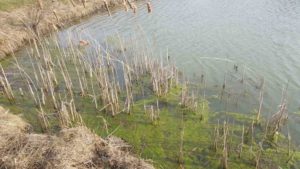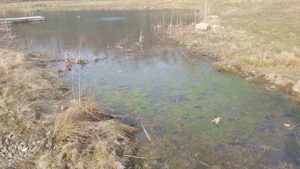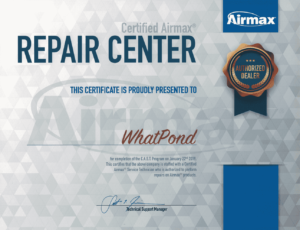Looks like this year was a light winter same as last year. Also seems that we had more warm ups and warmer temperatures to go along with the snow melts.
It does seem we had some flow through in the ponds, pond dye is washed out for sure but did we get a good flushing? So far this year, end of my birthday month February we stand around 83 inches of snow for the season. With 77 degree day on Friday to snow on Saturday afternoon, and back to the teens for overnight.
Here we are in mid March, the ice is off and algae is showing. This species of algae is not too much of a problem as it will eventually go away. But once the water gets closer to 60 we’ll be looking at the species algae that is more troublesome. Growing up from the bottom from dead decaying leaves, plants and other organic debris that has settled on the pond bottom.
I know the first thing we want to do is find the best chemical to kill the algae so we don’t have to look at it. Great now we don’t see the algae and the problem is fixed? Not really. All we really did was kill the algae and the algae now becomes more nutrients for more algae to grow from, along with consuming oxygen as it decays. Just like a wheel that goes round and round. The algae grows, we kill it, it dies, and grows again, from the nutrients.
Controlling algae in a way that is good for nature and other critters in and around the pond can be achieved by proper sized aeration and beneficial pond bacteria’s. We use two different formulations, our water soluble packets deal most with the water column removing nutrients and has some strain of bacteria for the muck and sludge on the bottom. Our pellets and blocks are designed for the muck and sludge as they sink right to the bottom to get to work. The bacteria’s job is consume the organic nutrients that the algae need to grow and reduce muck and sludge. The added aeration provides oxygen for the bacteria’s to each deeper depth in the pond and of course provide fish oxygen so they can thrive. Additionally adding water movement and oxygen from top to bottom of the water body.
Now that we are at the end of March, we’ve had another snow storm since I started this article warm weather for a few days and hearing more snow next week. Lots of up and down with the weather and winds.
With the wind and light winter, with ponds deiced we are getting some surface aeration so that is better news than having the ponds iced over for months on end which raises the chance for fish kills. Surface aeration alone will not prevent a fish kill. So the importance of bottom diffused aeration helps to keep the fish alive all year long.



